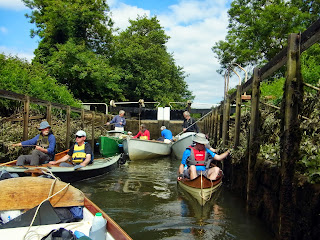Going up the Kennet Navigation from Reading to Newbury was interesting. I had assumed that it would be canal-like with virtually no current, but the early 18th century engineers had clearly been told to keep spending to the absolute minimum. The natural and rather steep river bed was used wherever possible, with artificial cuts being dug only to take boats up to the locks.
It can be quite a slog, especially in a notorious stretch through Reading called the Brewery Gut, where the canal company could not divert the stream because of a brewery. The drop is particularly sharp and the course winding. The prospect of a 70ft narrowboat labouring slowly upstream meeting a 70ft narrowboat hurtling out of control downstream is too horrible to contemplate so the stretch is controlled by traffic lights. You have 12 minutes to clear the stretch.
I have to say that us rowers seemed to manage with far less grumbling than the paddlers.
The pictures show another 18th century cost-saving measure, a turf-sided lock.
 These are very rare now, having been replaced by proper brick and stone walls everywhere else. The sloping sides may have been cheaper to build but waste astonishing amounts of water. In a totally artificial canal this is a big problem but on the Kennet water was plentiful.
These are very rare now, having been replaced by proper brick and stone walls everywhere else. The sloping sides may have been cheaper to build but waste astonishing amounts of water. In a totally artificial canal this is a big problem but on the Kennet water was plentiful.
The first time we were faced with the torrent of water coming through the paddles in the top gates everyone's faces froze in panic. By the end of the trip most people used the stops in locks to tidy up in the boat, send a few texts and generally relax.



3 comments:
At least the grumbling Paddlers could see the 70ft boat hurtling towards them.
Yours
A Grumbling Paddler.
We'd never see it coming, and die happy.
Chris,
Thanks for the uplifting photos. It's clear that everyone's level of enjoyment was raised, paddlers and rowers alike.
- Michael H.
Post a Comment